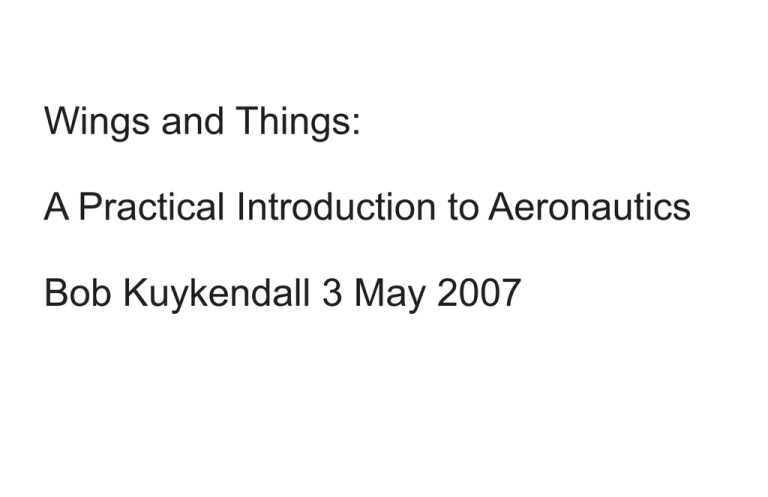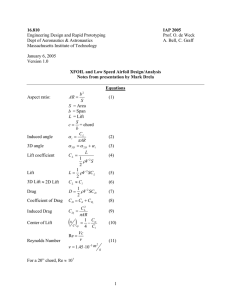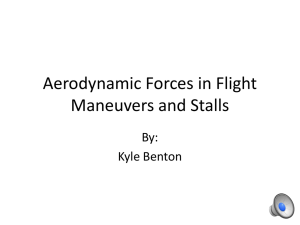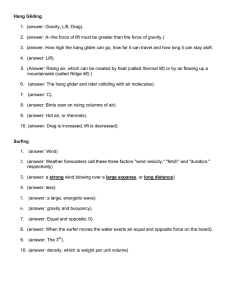Wings and Things - HP Aircraft, LLC
advertisement

Wings and Things: A Practical Introduction to Aeronautics Bob Kuykendall 3 May 2007 Bernoulli's Principle Increasing the speed of a fluid or gas decreases its pressure. As applied to a Venturi Higher speed Lower pressure Bernoulli's Principle As applied to half of a Venturi Higher speed Lower pressure Bernoulli's Principle As applied to an airfoil LIFT Higher speed Lower pressure Airfoil Terms Relative Wind Chord Airfoil Chord L ine Leading Edge Angle of Attack Trailing Edge Airfoil - The shape used for the cross-section of a wing or other lifting surface. Leading Edge - The front edge of the airfoil. Usually rounded. Trailing Edge - The back edge of the airfoil. Usually sharp. Chord - The straight-line distance between the leading edge and the trailing edge. Chord Line - A straight line between the leading edge and the trailing edge. The chord line is used as a reference for measuring the angle of attack. Angle of Attack - The angle between the airfoil (measured at the chord line) and the relative wind. Relative Wind - Air moving over the airfoil, either because the air is still and the airfoil is moving, or because the airfoil is still and the air is moving. Basic Airfoil Forces: Lift and Drag Lift Drag Lift - The upward pull of the airfoil at a right angle to the relative wind. Lift is caused by the pressure difference between the upper and lower surfaces of the airfoil. Drag - The rearward pull of the airfoil parallel to the relative wind. Some drag is caused by friction between the airfoil and the air, and some is created as a byproduct of making lift. About that pressure difference... Pressure is a force applied over an area. For an example of pressure, think about the air inside a bicycle tire, typically around 40 PSI or pounds (the force) per square inch (the area). One square inch (square) One square inch (round) Experiment Time: Lifting a Bowling Ball Question: Suppose you have a vacuum cleaner capable of 1.2 PSI (pounds per quare inch) of vacuum. Is the vacuum cleaner strong enough to lift a 12-pound bowling ball? Experiment Time: Lifting a Bowling Ball Answer: Yes, easily! The 2" hose on most vacuum cleaners has a cross-section area of about 3.14 square inches. 3.14 square inches times 1.2 pounds per square inch is about 3.8 pounds. Not enough to lift the 12 pound ball. But adding an 8" funnel to the hose increases the area to about 50 square inches. 50 square inches times 1.2 PSI is about 60 pounds, enough to lift five bowling balls! 8.00" The formula for the area of a circle is: A=pi*r2 A=pi*42 =3.14*16 =50.24 square inches 8.00" The area of an 8" diameter circle is: 4.00" radius Lift and Pressure Difference A wing produces lift because its airfoil shape creates low pressure over the top surface and high pressure under the bottom surface as it moves through the air. Question: How great does the pressure difference have to be? How big a pressure difference are we talking about? LIFT Lift and Pressure Difference Answer: Not very great at all! Consider a small airplane that weighs 1000 pounds, has a 20-foot wingspan and 5-foot chord. The airplane has a wing area of 100 square feet (20 X 5). There are 144 square inches per square foot. So the airplane has a wing area of 14,400 square inches. In order to lift off the ground, the wings only have to produce a pressure differential of 1000 / 14,400 = 0.069 pounds per square inch. That's about 1/500th of the air pressure in a typical car tire. Lift and Airspeed The amount of lift made by a wing is relative to its airspeed as well as its angle of attack. The greater the airspeed, the greater the lift. LIFT 40 m.p.h LIFT 60 m.p.h Lift and Angle of Attack The amount of lift made by a wing is relative to its angle of attack. The steeper the angle of attack, the greater the lift. But only to a certain degree... LIFT LIFT Stall! Above a certain angle of attack, the air unsticks or "separates" from the top of the wing. Instead of flowing smoothly, it swirls in turbulent eddies like whirlpools in a river. LIFT LIFT When the air separates from the top of the wing, the pressure difference between the top and bottom of the wing becomes weaker, causing the wing to make much less lift. The separated flow also produces much more drag than when the air flows smoothly. LIFT Why can airplanes fly upside-down? You've seen airplanes fly upside-down at airshows and on television. Airfoils work fine upside-down, they're just less efficient, so it takes more power to maintain level flight. LIFT LIFT Use the (four) Forces! Thrust is created by an engine that accelerates a part of the airflow. LIFT Lift is produced by air flowing over the wings and other lifting surfaces. DRAG THRUST In level flight, lift balances weight and thrust balances drag. WEIGHT Weight is caused by the Earth's gravity attracting the aircraft's mass. Drag is caused by air resistance, and also as a byproduct of lift. What if the engine quits? LIFT Without the engine's thrust, drag will slow the airplane down. As the airplane slows down, lift decreases, allowing weight to pull the airplane down. Unless... DRAG NO THRUST! WEIGHT Let's Use Vectors Lift 1200 lbs We can use vectors to see what forces act on the airplane. We'll draw the vectors as lines of different lengths. The length of the line shows the strength of the force, and the direction of the line shows the direction in which the force acts. Drag 200 lbs Thrust 200 lbs Drag 200 lbs Weight 1200 lbs Lift 1200 lbs Putting all of the vectors nose to tail, in any order, shows us the sum of all the vectors. In this case, the vectors end up where they started, showing perfect balance. The airplane is in straight and level flight at a constant speed. Weight 1200 lbs Thrust 200 lbs Forces in Gliding Flight Let's say our airplane weights 1200 lbs and has a lift-to-drag ("L/D") ratio of 6:1 at some speed like 60 m.p.h. At 60 mph, our airplane produces 1200/6=200 lbs of drag. Lift Drag Drag ht g i l F g n i t l u s e R 0 1 t u o b Path (a d o w n ) s e e r g e d Weight We can overcome the 200 lbs of drag by lowering the nose. That tips the lift vector forward. The forward component of the lift vector balances out the drag vector. That keeps the airplane from slowing down. Lift Weight Forces on "Real" gliders (Sailplanes) Modern sailplanes will typically have best L/D ratios of around 40:1. That means that the sailplane produces only one unit of drag for every 40 units of lift. It also means the sailplane loses only one foot of altitude for every 40 feet of forward motion. To go 50 miles, the sailplane only needs 6600 feet of altitude. Some high-performance sailplanes have best L/D ratios as great as 70:1! Resulting Flight Path (Less than 1.5 degrees down) Evolution of Glider Airfoils Clark Y NACA 23012 NACA 653-618 Used in many early gliders and small airplanes. Flat bottom makes it easier to build on top of a table. Developed by NACA (forerunner of NASA) in the 1930s. Still used on many small airplanes, and even some light jets. Has low pitching moment. Developed by NACA in the 1940s. Similar to the airfoil used on the P-51 Mustang. Emphasizes low drag and laminar flow. Wortman FX67-K-150 Developed by Dr. Felix Wortmann in the 1960s. Achieves extremely low drag and high L/D values, but very sensitive to contamination. Wortman FX81-K-136 Developed by Dr. Felix Wortmann in the 1980s. Improves on the FX67 series with similar performance over a wider range of conditions.



